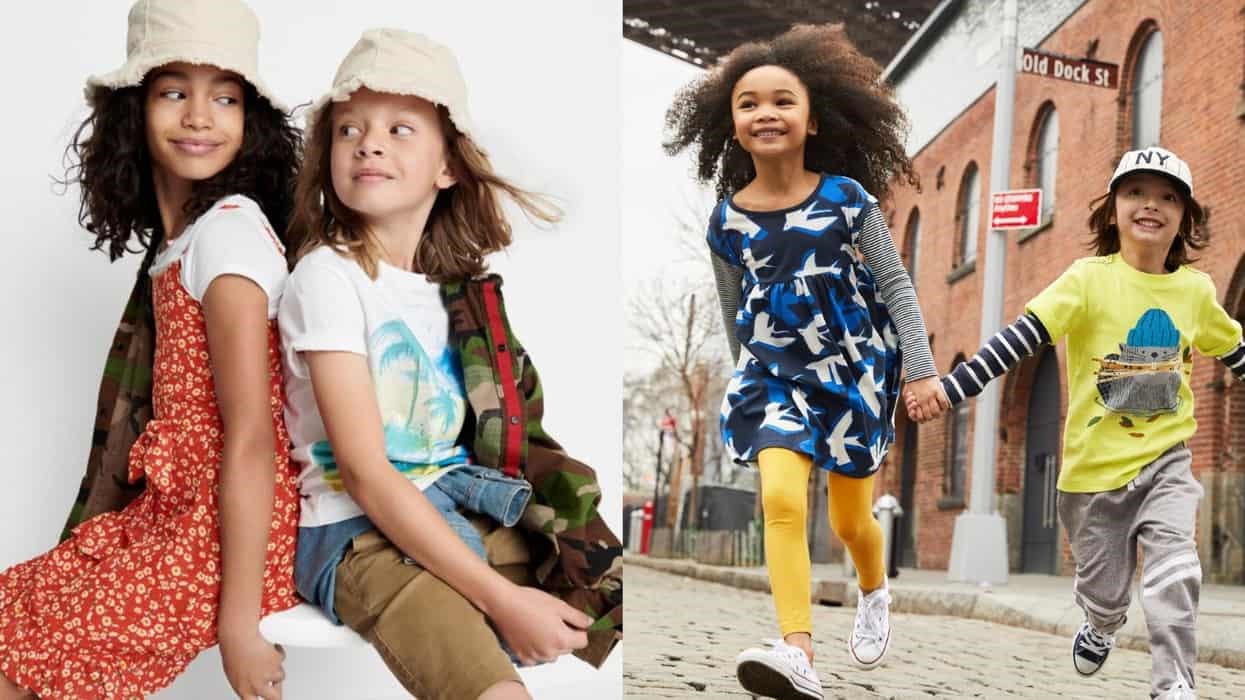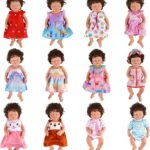Yes, kids’ fashion trends significantly impact their social interactions. Clothing choices can influence friendships, peer acceptance, and self-esteem.
Fashion plays a vital role in children’s lives, shaping their identities and social experiences. As kids grow, they become more aware of trends and how their outfits affect their social standing. Wearing popular brands or styles can lead to increased confidence and acceptance among peers.
Conversely, kids who don’t align with current trends might feel excluded or face bullying. This dynamic illustrates the powerful connection between fashion and social relationships in childhood. Understanding these influences helps parents guide their children in making positive fashion choices that foster healthy interactions and self-expression.
Table of Contents
Introduction To Kids Fashion
Kids fashion plays a big role in children’s lives. Clothing styles affect how they express themselves. Fashion can influence their social interactions and friendships. Understanding kids’ fashion trends helps us see their world better.
The Rise Of Children’s Style
The popularity of children’s fashion has grown rapidly. Parents now invest more in stylish clothes for their kids. Many brands focus specifically on kids’ trends. These brands create vibrant and unique designs. Here are some reasons for this rise:
- Social Media Influence: Kids see trends on platforms like Instagram.
- Celebrity Endorsements: Famous personalities set style examples.
- Availability: More stores offer fashionable kids’ clothing.
Children often want to mimic their favorite characters. This desire shapes their clothing choices. They feel special wearing trendy outfits. Fashion allows them to showcase their personalities.
Influence On Early Development
Fashion impacts kids beyond appearance. It affects their confidence and social skills. Wearing trendy clothes can help them fit in. Here are some ways fashion influences early development:
| Aspect | Impact |
|---|---|
| Self-Expression | Kids use clothes to show their identity. |
| Peer Interaction | Fashion can encourage friendships. |
| Confidence | Stylish outfits boost self-esteem. |
Fashion choices can lead to positive or negative experiences. Kids may feel excluded if they don’t follow trends. This can affect their emotional well-being. Parents should balance style and comfort in kids’ clothing.
Historical Evolution Of Kids Fashion
The history of kids fashion shows how style has changed over time. What children wear impacts their social life. Fashion trends influence how kids interact with their peers. Understanding this evolution helps us see these connections.
From Function To Fashion
Kids’ clothing used to be all about function. Parents needed durable clothes for playtime. As time passed, fashion became more important.
- Early 1900s: Children wore practical outfits.
- 1920s: Bright colors and patterns appeared.
- 1950s: Iconic styles like poodle skirts emerged.
- 1980s: Bold and flashy fashion took over.
- 2000s: Casual wear became popular.
Today, kids often choose clothes based on trends. Fashion is not just for adults anymore.
Key Milestones
| Decade | Fashion Highlights |
|---|---|
| 1900s | Practical clothing for everyday use. |
| 1920s | Introduction of playful styles and brighter colors. |
| 1950s | Poodle skirts and tailored outfits became popular. |
| 1980s | Neon colors and extravagant designs ruled. |
| 2000s | Casual wear, like jeans and T-shirts, gained popularity. |
These milestones show how kids’ fashion has changed. Each era brought new ideas and styles. Today’s trends reflect kids’ personalities and influence their social lives.
Current Trends In Children’s Apparel
Kids’ fashion trends change quickly. Styles reflect their interests and personalities. Bright colors and fun designs dominate the market. Comfort is key for both kids and parents. Many brands focus on eco-friendly materials. This trend encourages kids to express themselves while caring for the planet.
Popular Brands And Styles
Many brands shape children’s fashion today. Here are some popular ones:
- Nike – Known for sporty styles.
- Adidas – Offers trendy athletic wear.
- HM – Affordable and stylish options.
- Gap Kids – Classic styles for everyday wear.
- Mini Rodini – Focuses on sustainability and fun prints.
Current styles include:
- Graphic tees with fun slogans.
- Denim jackets with patches.
- Bright sneakers.
- Joggers and leggings.
- Animal prints and vibrant colors.
The Role Of Social Media
Social media greatly influences kids’ fashion choices. Platforms like Instagram and TikTok showcase trends. Kids see their favorite influencers wearing cool outfits.
Popular trends often go viral. Kids want to dress like their favorite stars. This creates a desire for specific brands and styles. Parents notice their children asking for trendy items.
Social media makes fashion accessible. Kids share their outfits online. They connect with friends through style. This builds confidence and creativity in their choices.
Brands use social media to market to kids. They collaborate with influencers. This strategy helps them reach a younger audience. It keeps kids excited about new collections.

Credit: health.clevelandclinic.org
The Social Dynamics Of Dressing Up
Dressing up plays a big role in how kids interact. Clothes can influence friendships, confidence, and even mood. Kids notice what their peers wear. Trends can create a sense of belonging or exclusion. Understanding this social dynamic helps parents guide their children.
Peer Pressure And Clothing Choices
Peer pressure is strong in childhood. Kids often feel the need to fit in. This can lead to certain clothing choices. Here are some effects of peer pressure:
- Popularity: Wearing trendy clothes can boost status.
- Exclusion: Kids not wearing the latest styles may feel left out.
- Confidence: The right outfit can increase self-esteem.
Parents can help by encouraging individuality. Open discussions about clothing can reduce peer pressure.
Fashion As A Social Statement
Fashion is more than just clothes. It often expresses identity and beliefs. Kids use fashion to show who they are. Here are some ways fashion acts as a social statement:
- Trends: Following trends can signal belonging.
- Personal Style: Unique outfits showcase individuality.
- Causes: Clothes can represent social issues or movements.
Understanding these aspects can help kids communicate better. Fashion choices can create connections among peers.
| Fashion Impact | Description |
|---|---|
| Confidence | Wearing stylish clothes boosts self-esteem. |
| Belonging | Trendy outfits create a sense of community. |
| Expression | Fashion allows kids to express their identity. |
Psychological Effects Of Fashion On Children
Fashion influences children’s thoughts and feelings deeply. Clothes shape their self-image and interactions. Trends can boost confidence or create anxiety. Understanding these effects is crucial for parents and educators.
Self-expression And Identity
Fashion acts as a canvas for children to express themselves. Clothing choices help kids show their personality. Each outfit tells a story about who they are.
- Colors: Bright colors often reflect joy and energy.
- Styles: Unique styles help kids stand out.
- Accessories: Items like hats or jewelry add flair.
Through fashion, children explore their identity. They experiment with different looks. This exploration builds their confidence.
Impact On Self-esteem
Fashion choices directly affect children’s self-esteem. Wearing trendy clothes boosts confidence. It helps them feel accepted by peers.
| Fashion Element | Effect on Self-Esteem |
|---|---|
| Trendy Outfits | Higher confidence and social acceptance |
| Outdated Styles | Feelings of exclusion or low self-worth |
Peer opinions play a significant role. Kids often compare their outfits to others. Positive feedback can enhance their mood. Negative remarks can lead to insecurity.
Encouraging individual style can promote self-acceptance. Children should feel free to wear what they love. This freedom nurtures a healthy self-image.

Credit: www.apa.org
Parental Influence On Children’s Fashion
Parents play a crucial role in shaping their children’s fashion choices. Kids often look up to their parents for guidance. Their style preferences can be influenced by what parents wear and suggest.
Guiding Style Choices
Parents can help kids develop their own style. Here are some ways to guide their fashion choices:
- Encourage creativity: Let children mix and match outfits.
- Set a budget: Teach kids about spending wisely.
- Choose quality: Help them select durable clothing.
Parents can also share their fashion experiences. This bonding can build confidence in children.
Balancing Comfort And Trends
Comfort is essential for kids. They need to feel good in what they wear. Here are tips for balancing comfort with style:
- Assess the occasion: Choose outfits based on activities.
- Check the fabric: Soft and breathable materials are best.
- Involve kids: Let them express their preferences.
Fashion trends come and go. Parents should ensure their children feel at ease while looking stylish.
Economic Factors And Accessibility
Fashion trends can greatly affect kids’ social lives. These trends often depend on economic factors. Not all families can afford the latest styles. Understanding these factors helps to see how kids interact.
Cost Of Keeping Up With Trends
Keeping up with the latest fashion trends can be expensive. Kids want to wear what their friends wear. Here are some costs associated with trendy clothing:
| Item | Average Cost |
|---|---|
| Designer Sneakers | $100 – $300 |
| Trendy Jackets | $50 – $150 |
| Graphic Tees | $20 – $50 |
| Accessories | $10 – $40 |
Many families struggle to meet these costs. Some kids may feel left out. This can lead to feelings of insecurity and isolation.
Secondhand And Sustainable Options
Secondhand clothing offers a cost-effective solution. Many thrift stores sell stylish clothes at low prices. Kids can find unique pieces that stand out.
- Thrift Stores
- Online Marketplaces
- Clothing Swaps
Sustainable options are also gaining popularity. Buying fewer new items helps the environment. Parents and kids can choose eco-friendly brands.
- Research brands that focus on sustainability.
- Consider swapping clothes with friends.
- Explore local thrift shops for hidden gems.
These options allow kids to express themselves without breaking the bank.
Fashion And Inclusivity
Fashion should celebrate every child. Inclusivity in fashion helps kids feel accepted. It builds confidence and fosters friendships. Today, brands focus on creating inclusive clothing. This change impacts how kids interact with each other.
Adaptive Clothing For All
Adaptive clothing makes dressing easier for kids with disabilities.
- Easy closures like Velcro and magnets
- Stretchy fabrics for comfort
- Designs that allow for movement
These features help kids express themselves. They feel empowered to join in activities. Friends notice and appreciate these choices. Adaptive clothing promotes a sense of belonging.
Representation Matters
Seeing diverse styles is important for children. Representation in fashion reflects real life.
- Different cultures
- Varied body types
- Gender-neutral options
When kids see themselves in clothing, they feel valued. This visibility encourages acceptance among peers. It helps break down stereotypes. Kids learn to embrace differences through fashion.
The Role Of Schools And Uniforms
Schools play a huge role in shaping kids’ fashion trends. Uniforms can affect social interactions. They create a sense of belonging. Casual dress days allow kids to express their identities.
Uniforms As Equalizers
Uniforms are a way to level the playing field. They help reduce peer pressure about clothing. Here are some benefits of uniforms:
- Reduces bullying: Kids focus less on fashion.
- Encourages teamwork: Everyone wears the same outfit.
- Saves money: Parents spend less on clothing.
- Boosts school spirit: Unity in appearance fosters pride.
Uniforms make it easier for kids to bond. They focus on friendships rather than fashion choices. This can lead to more meaningful social interactions.
Casual Dress Days And Identity
Casual dress days offer kids a chance to shine. They express their personal style. This can impact how they connect with peers. Here’s how casual dress days affect social interactions:
| Aspect | Impact |
|---|---|
| Self-Expression | Kids showcase unique personalities. |
| Peer Comparison | Kids may feel pressure to fit in. |
| Confidence | Wearing favorite clothes boosts self-esteem. |
| Social Dynamics | Fashion choices can affect friendships. |
Casual days can be both exciting and stressful. Some kids love the freedom. Others may worry about fitting in. Balancing self-expression with social acceptance is key.
The Impact Of Celebrity Kids On Trends
Celebrity kids have a huge influence on fashion trends. Their style choices often shape what children want to wear. Parents and kids look up to these young stars. They inspire new trends in clothing, accessories, and even hairstyles.
Influencer Families
Influencer families have taken social media by storm. They showcase their lifestyles and fashion choices. This visibility impacts children’s fashion significantly.
- Parents follow these families for style ideas.
- Kiddos often imitate their favorite influencer’s outfits.
- Brands collaborate with these families for new collections.
These families create a cycle of trends. Their influence drives kids to ask for similar items. The impact can be seen across various platforms.
The Reach Of Young Celebrities
Young celebrities have a broad reach. They connect with fans through social media. Platforms like Instagram and TikTok amplify their influence.
| Celebrity Kid | Platform | Trend Impact |
|---|---|---|
| North West | High-end fashion | |
| Blue Ivy Carter | Luxury brands | |
| Stormi Webster | TikTok | Casual chic |
Kids admire their outfits and want similar styles. This trend often leads to increased sales for brands. Young celebrities set the stage for what is cool and trendy.
Fashion trends among kids often mirror those set by these stars. Parents find themselves buying the latest styles to keep up.
Marketing To The Young Demographic
Kids’ fashion trends shape their social lives. Brands target young audiences through clever marketing. Understanding these strategies helps parents and educators navigate this world.
Advertising Strategies
Brands use various methods to attract kids. Here are some effective strategies:
- Social Media Engagement: Platforms like Instagram and TikTok reach kids effectively.
- Influencer Partnerships: Collaborating with popular young influencers boosts brand visibility.
- Interactive Content: Games, quizzes, and challenges engage kids actively.
- Colorful Visuals: Bright colors and fun designs catch kids’ attention.
These strategies create a sense of belonging among peers. Kids are drawn to brands that their friends endorse.
Ethical Considerations
Marketing to children raises important ethical questions. Here are key points to consider:
| Concern | Description |
|---|---|
| Manipulative Techniques | Using peer pressure to influence buying choices. |
| Age-Appropriateness | Ensuring ads are suitable for children’s understanding. |
| Privacy Issues | Protecting children’s data from exploitation. |
| Health Impacts | Avoiding promotion of unhealthy habits or products. |
Parents must guide children about advertising tactics. Awareness helps kids make informed choices.
The Future Of Kids Fashion
The world of kids fashion is changing quickly. New trends emerge every season. Parents and kids both want stylish options. The future holds exciting innovations that can enhance style and comfort.
Technological Innovations
Technology is reshaping how kids dress. Here are some exciting developments:
- Smart Fabrics: These fabrics adjust to temperature and activity.
- 3D Printing: Custom designs made quickly and easily.
- Wearable Tech: Gadgets integrated into clothing for fun and function.
These innovations make fashion more interactive. Kids can express themselves better with tech-friendly options.
Predicting The Next Big Trend
Fashion trends often reflect society’s values. Current trends point towards:
- Sustainability: Eco-friendly materials are becoming popular.
- Diversity: Styles that celebrate different cultures.
- Comfort: Clothes designed for active play and movement.
Fashion brands will likely focus on these themes. Understanding kids’ preferences is key to predicting trends. Social media also plays a huge role in shaping what kids want to wear.
| Trend | Impact on Kids |
|---|---|
| Sustainability | Kids learn about caring for the planet. |
| Diversity | Kids appreciate different cultures and styles. |
| Comfort | Active play is encouraged with comfy clothes. |
The future of kids fashion is bright and full of possibilities. Kids will enjoy unique and meaningful choices.
Conclusion: Balancing Fashion And Well-being
Fashion plays a big role in kids’ lives. It can shape their social interactions. Parents must find a balance between trends and well-being. This ensures kids feel confident and happy.
Encouraging Positive Social Interactions
Fashion can help kids connect with others. It creates common ground. Here are some ways to promote positive interactions:
- Support group activities like team sports.
- Encourage kids to share their fashion ideas.
- Teach them about kindness and acceptance.
Positive interactions enhance self-esteem. Feeling good about their appearance boosts confidence. Kids learn to express themselves through fashion.
Fostering Individuality Over Trends
Individuality is key in a child’s development. Trends can pressure kids to conform. Parents should encourage unique styles.
| Benefits of Individuality | Impact on Kids |
|---|---|
| Boosts self-confidence | Kids feel more secure in who they are |
| Encourages creativity | Kids express their personality through fashion |
| Reduces peer pressure | Kids learn to embrace differences |
Teaching kids to embrace their style fosters strong self-identity. This helps them navigate social situations with ease. Individuality builds resilience against negative influences.

Credit: www.sandstonecare.com
Frequently Asked Questions
Do Fashion Trends Affect Kids’ Friendships?
Fashion trends can influence how kids connect, shaping group dynamics and social circles based on clothing choices.
How Do Trends Impact Children’s Self-esteem?
Trendy outfits often boost self-esteem, as kids feel more accepted and confident among peers who value style.
Can Fashion Choices Lead To Bullying?
Yes, kids may experience bullying over fashion choices, highlighting the importance of promoting individuality and acceptance.
What Role Do Parents Play In Fashion Trends?
Parents influence kids’ fashion choices through purchasing decisions, setting examples, and fostering discussions about self-expression.
Conclusion
Kids’ fashion trends play a significant role in shaping their social interactions. Clothing choices can influence friendships and self-esteem. Understanding these dynamics can help parents guide their children in making confident fashion decisions. Embracing individuality in style fosters positive social experiences and helps kids connect with others on a deeper level.







